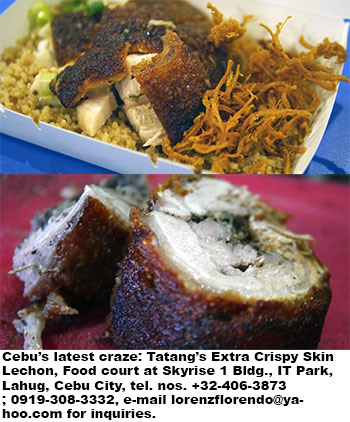Cebu overdrive

As mentioned in my last two articles on Cebu, the trinity su-tu-kil forms the very foundation of Cebuano cooking: sugba, to grill over charcoal; tula, to boil into a soup; and kilaw, to soak or wash in vinegar.
One of the more popular su-tu-kil joints is Parr’t Ebelle, and this is what it does with its fresh seafood catch of the day and nothing but. It is named after its owner, Ebelle, with Parr’t as short for “partner,” which Cebuano men endearingly call each other.
Mary Ann and I got there around 11 a.m., which turned out to be the best time to be there, as we had the first pick of large cuts of seafood being grilled on a long charcoal pit by the entrance. Further inside the open hall are a glass-encased food display where bowls of kinilaw are already portioned, and two large cauldrons of tula and larang soups are kept simmering.
Now for the kill: Taking our chances on which to order among the assorted fish slabs and large squids (pusit lumot or cuttlefish) being grilled, we chose a two-inch-thick half-steak of tasik (a kind of sea catfish, we were told), which was oozing with natural fat and juices when cut into. As for the soup, we passed up the austere clear-broth tula nga tangige and opted for the larang nga tasik, a kind of spicy soup made with tasik head and its jaws, also oozing with fat — yummy Omega-3!
To call larang a soup wouldn’t do it justice. It is more of a fish stew simmered for long hours with a caboodle of tomatoes, garlic, onion, leeks, kamias, green finger chilies, ginger and tausi/ fermented black beans to create a rich, thick, full-bodied stew (think bouillabaisse), that would make one break into a sweat. The kinilaw nga rumpé (chevron barracuda) was lackluster, though, and is better skipped.

By noon, throngs of the lunch crowd had arrived. One points at the grilled fish desired, and it is then reheated (see what we mean by arriving early; reheated cooked fish tends to get dry and tough). Weeks after our visit, I still dream of the fat, juicy tasik steak and fish head larang stew, while Mary Ann dreaded the experience as she abhors fatty fishes, its belly and head, not to mention the unwanted guests that hovered over our food (pesky flies). “But we could have dined in the air-conditioned room,” I reasoned, the extra charge notwithstanding.
Meanwhile, in the sugba tradition of grilling or roasting pork, there’s quite a number of lechoneros vying for an ever-increasing demand for the whole roasted pig (old folks still call it sinugba nga baboy, so technically it falls under the sugba tradition.) After all, the famous American writer/ TV host Anthony Bourdain declared Cebu’s Zubuchon as No.1 in the world when he tried it way back in 2008, dislodging Puerto Rico and Bali on his list. Cebu could very well be the nation’s lechon capital.
But where Bourdain left off, a new lechon craze has emerged from the smoldering heap. It is the deboned liempo or midsection of the pig that is flavored with salt, garlic, lemongrass and other aromatics, then rolled and speared into a rotisserie over a charcoal pit. It is called boneless lechon roll/ roulade, popularized by the chain Balamban Liempo, which originates from Balamban town in western Cebu.
Fast catching up in popularity is Tatang’s Extra Crispy Skin Lechon. It has literally an extra crispy and blistery crackling, with its meat remaining tender and juicy. It has been attracting a strong following, especially among the discerning foodies in Cebu and Metro Manila, where orders are flown in daily, including to our guru, Glenda Barretto of Via Mare Café.
Tatang’s is owned by Lorenz Florendo, a 28-year-old Cebuano who named it after his grandfather, whom they addressed as tatang. He taught for two years after finishing a special education degree in Ateneo de Manila, but he realized his true calling is the food business. He spent much time developing the marinade for the flavor he wanted and then started preparing the lechon in his family kitchen. Though boneless lechon has been around Cebu for years, it is Lorenz’ own blend of seasonings and its blistery crisp skin that contributed to its success in the less than two years since its opening in 2012.
Sold at P495 per kilo, he sells 50 to 100 kilos a day, including bulk orders from Manilans who don’t seem to mind the added airfreight cost. At his branch in the IT Park, we had the 80-gram serving with both adobo rice (or java rice as a choice) and it was indeed crispy, though on the salty side, as expected of Cebu lechon, which Mary Ann loved. Add P17 and you get fried lechon flakes. Tatang’s is now open for franchising, with two branches in Davao City doing brisk business as well.



















